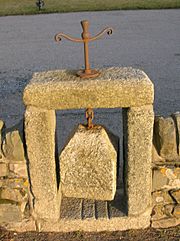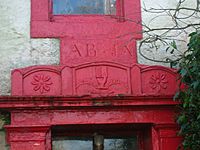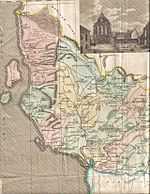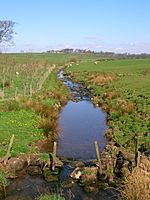Barbara Gilmour facts for kids
Quick facts for kids 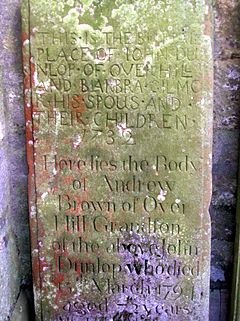
Barbara Gilmour's Gravestone
|
|||||
| Died | 1732 Dunlop, East Ayrshire |
||||
|---|---|---|---|---|---|
| Burial | Dunlop | ||||
| Spouse | John Dunlop | ||||
| Issue More |
Mary Dunlop | ||||
|
|||||
Barbara Gilmour (also known as Barbara Dunlop) was an important person in the 17th century. She lived near Dunlop, East Ayrshire, a village in Scotland. Barbara taught people a special way to make cheese. This method became very popular. It helped farmers and others earn more money. The cheese made using her method became famous as "Dunlop cheese".
Contents
Barbara's Early Life
Barbara Gilmour was a clever woman. She became very smart after living in Ireland around 1660. She had to leave Scotland because she was a Presbyterian. During her time in Ireland, she learned how to make cheese using whole milk.
Some people think she was in the Bantry Bay area of County Cork. Others say she was in County Down, Northern Ireland. It's not clear exactly where she came from. But "Gilmour" is a common name in her home area.
Another story says Barbara was a very religious young woman. She heard about a sad event where a Covenanter named Margaret Wilson died. To avoid giving up her beliefs, Barbara fled from Ayrshire to Ireland. There, she found work in County Down. This is where she learned the Irish way of making cheese. After things calmed down, Barbara returned home to Dunlop. She then married a farmer named John Dunlop.
Making Her Mark with Cheese
After the Revolution of 1688, Barbara returned to Dunlop, East Ayrshire. She brought her special cheese recipe with her. Some say she mixed the best Scottish and Irish cheese-making ideas. This created the famous Dunlop cheese.
Barbara was married to John Dunlop, who farmed at Overhill Farm, now called The Hill. Introducing a new type of cheese was not easy. Some local people thought cheese could only be made from skimmed milk. They almost accused Barbara of witchcraft. This was a serious charge that could have led to her being burned.
Some people also said she copied their recipes. A farmer named Mr. W. Aiton said that cheese makers already knew about adding cream. He thought Dunlop cheese was named after a trader who sold it in Glasgow. Others doubt the Irish origin of the recipe. But they still agree that Barbara Gilmour helped make Dunlop cheese popular.
Old Cheese Presses at The Hill Farm
Many sources say Barbara Gilmour's cheese press can still be seen at The Hill farm. However, the press there is from 1760. Barbara died in 1732, so it wasn't her personal press.
This type of press used a heavy stone with a screw. This allowed the stone's weight to press down on the cheese. This helped drain the whey and make the curd firm.
There is another stone at the farm. It might be an older, simpler cheese press. It's a carved trough with holes and grooves. It might have been used for something else later.
The Hill Cheese Presses, 2007
The Hill Farm and Old Roads
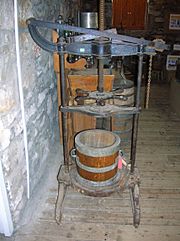
The Hill farm is shaped like a "U". It hasn't changed much since the 1800s. This means you can still see older parts of the farm. The farm has a two-story farmhouse. It also has stables, a harness room, and a forge. To the north, there's a cow shed and a dairy. A barn and cart shed are behind the main buildings. There's also a small watermill near the dairy.
The farm buildings are made of stone and have slate roofs. They have many date stones and marriage stones built into them.
The old road from Glasgow to Irvine in the 1600s passed by The Hill farm. This made it easier to transport Barbara's cheeses. Back then, goods were moved by pack animals or sledges. An old map from 1604–1608 shows "O Hill," proving the farm is very old.
Barbara's Gravestone and Family
Barbara and John's gravestone is now standing upright against a wall at Dunlop kirk. It is very well preserved. The stone shows that Barbara died in 1732.
The gravestone mentions that they had children. However, only one daughter, Mary, lived longer than her parents. Mary married Allan Brown. Their son, Andrew Brown, later owned The Hill farm.
The Famous Dunlop Cheese
Barbara successfully made a type of cheese that was new to Scotland. It was made from unskimmed milk from the famous Ayrshire cows. Her method was copied by her neighbors. Soon, Dunlop cheese was in high demand. It sold well whether Barbara made it or her neighbors did. It's thought that farmers from Dunlop parish helped spread the cheese to other areas.
Barbara was very enthusiastic about making "sweet milk" (unskimmed milk) cheese. She was a strong and active person. She traveled widely to teach others how to make her Dunlop cheese. This created a demand for it all over Scotland. Merchants would visit the area to buy Dunlop cheese. They then sold it in markets across Scotland.
Barbara's way of making Dunlop cheese was copied widely. By the late 1700s, it was made in many parts of Scotland. Before this, only skimmed milk was used for cheese in the area. All cheese made in the western counties using her method was called "Dunlop." In 1837, records show that 25,000 stones of this cheese were made in Dunlop parish each year.
Dunlop cheese was especially valued in Ayrshire for roasting. A piece of oat cake or scone with roasted cheese and a bowl of milk was a popular and filling meal. It often replaced bacon for breakfast in many families.
Cadgers: The Cheese Sellers
Cadgers were middlemen who visited farms. They bought cheeses directly from farmers. Then, they sent the cheeses to markets in Glasgow, Edinburgh, and other places. By 1837, about fourteen cadgers made a living buying and selling Dunlop cheese in Dunlop Parish.
Dunlop cheese loses a lot of weight as it ages. This made dealers want to sell it quickly. So, it was often sold before it was fully ripe, and at a lower price.
A Poem About Making Dunlop Cheese
|
Recipe for Making Dunlop Cheese
This poem was written by the Rev. Hamilton Paul around 1800–1820. |
Ayrshire or Dunlop Cattle
Dunlop cattle are thought to have come from this area. J. Dunlop of that Ilk bred them from improved Dutch cattle between 1550 and 1700. The breed is also known as Cunninghame or Ayrshire cattle. They are white and brown, with short legs and long horns. The bulls can be fiery, but the cows are calm. Their milk has a lot of butterfat, which is perfect for making cheese.
It's interesting to note that breeding specific types of cattle was hard before the 1700s. Before then, land wasn't enclosed by dykes and ditches. Cattle could mix freely, making it almost impossible to keep a pure breed.
Fun Facts About Barbara Gilmour's Time
The British army and navy bought Barbara Gilmour's Dunlop-style cheese. This was because cheese made from skimmed milk was not popular with soldiers and sailors.
In the 1600s, Dunlop had two fairs each year to sell dairy animals. One was in May, and the other, called Hallowday, was on November 12.
A famous Ayrshire cow was given to the poet Robbie Burns in 1788. He said it was "the finest quey in Ayrshire." A 'quey' is a young cow that hasn't had a calf yet.
In Sir Walter Scott's book "Heart Of Midlothian," the Duke of Argyll says: "the Dunlop is the very cheese of which I am so fond." He asks for one to be sent to him, saying he is a "real good judge."
Timothy Pont's map from 1604–1608 says that the butter from Stewarton and Dunlop "serves a great part of the Kingdom." He noted that "one acre of ground here yields more butter than 3 acres of ground in any adjacent countries."
Today (2008), Dunlop cheese is still made at West Clerkland Farm. This farm is not far from Barbara Gilmour's old home.
Barbara Gilmour's Dunlop Legacy






